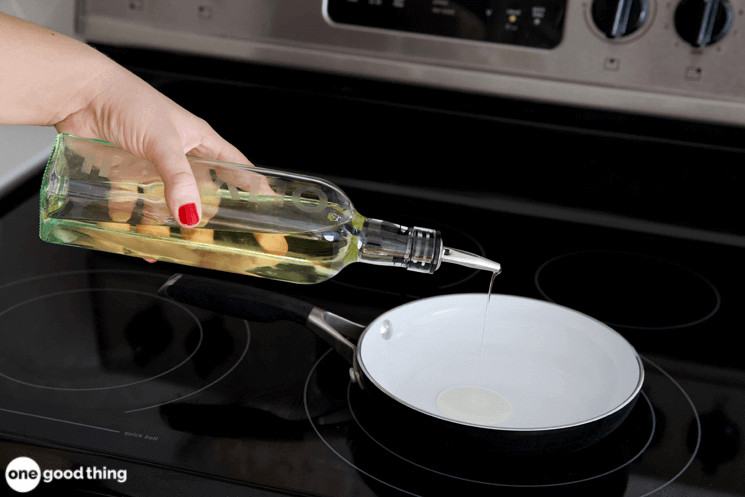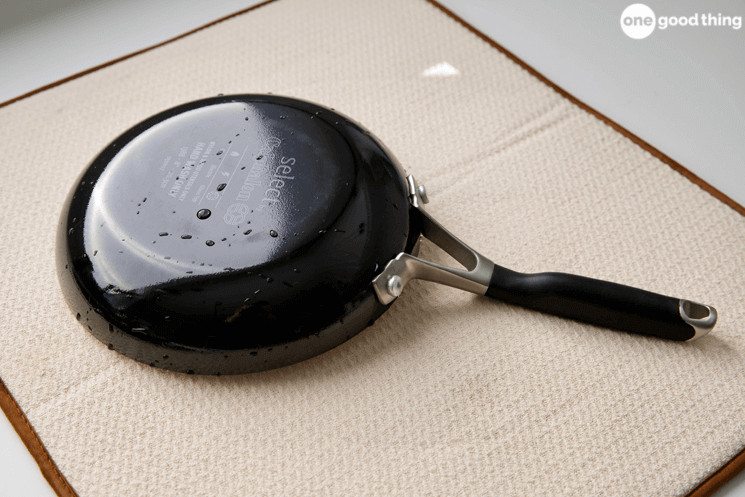
Every Tuesday, the OGT Team gathers virtually for our weekly planning meeting. We do get a lot done during these meetings, but I imagine that some of our conversations would seem pretty off-topic to an outside listener! But those meandering conversations often end up providing inspiration for future blog posts, and that’s exactly what happened with today’s post about nonstick pans. :-)
Related: The One Thing You Should Never Do After Cooking

During one such planning meeting, our photographer Kaitlyn mentioned that her husband had been getting on her case about using metal utensils on their nonstick pans. She told us that she had no idea there were special rules for using nonstick pans! So we got to talking about it, and we agreed that there was probably a lot we didn’t know about how to use and care for nonstick pans. I sensed a blog post in the making!
So I did some research, and came up with 11 common ways that people misuse their nonstick pans. I’ll be sharing those with you today, along with some helpful suggestions for turning those harmful habits into helpful ones. :-) (And for those of you who may be guilty of these nonstick no-no’s, you’re not alone! Between you and me, everyone on the team copped to several of these offenses, so there’s no judgment here!)
11 Ways You Mistreat Your Nonstick Pans

1. You Use Metal Utensils
As Kaitlyn discovered, using metal utensils on nonstick pans is a huge no-no! Nonstick finishes aren’t very durable, and using a metal utensil is sure to make lasting marks and scratches.
Instead… use wooden or silicone utensils when cooking on a nonstick pan. (For the same reasons, you should also use soft cloths and sponges when cleaning your nonstick pans.)

2. You Wash Them In Your Dishwasher
Harsh detergents and super hot water can both wear down a nonstick finish over time—even if the pan is labeled as “dishwasher-safe!”
Instead… hand wash your nonstick pans with a soft sponge and a little bit of baking soda. If you have a really stubborn or greasy mess in your pan, use a small amount of dish soap too.

3. You Use Cooking Spray
Cooking spray can build up and harden on a nonstick surface over time, creating a layer of residue that’s almost impossible to remove.
Instead… add butter or oil to the bottom of your nonstick pans when cooking.

4. You Pre-Heat Them Without Oil
Placing a “dry” nonstick pan over heat can release harmful chemicals into the air.
Instead… add your cooking fat of choice to the pan as soon as you place it over heat.

5. You Cook Over Very High Heat
Nonstick pans aren’t meant to be used over very high heat. High heat can damage the nonstick finish and release harmful chemicals.
Instead… use a cast iron pan when you need to cook something over high heat.

6. You Don’t Season Your Pans
Seasoning your nonstick pans isn’t strictly necessary, but it can help your pan last longer and improve the way your pan cooks.
Instead… season your pans by applying a small mount of oil to the inside of the pan before each use.

7. You Change Temperatures Too Quickly.
Fast temperature changes (like moving it from a hot stove to run it under cold water) can warp a nonstick pan.
Instead… let the pan cool off for a few minutes after cooking before you rinse or clean it.

8. You Let Them Sit In The Sink.
Exposing your nonstick pans to food or water for long periods of time can damage the finish.
Instead… wash your nonstick pans within an hour or two of using them. And be sure to dry them thoroughly before storing them!

9. You Cook Highly Acidic Foods
Cooking acidic foods like tomato-based sauces can quickly wear down a nonstick finish. (Putting a splash of something acidic in your pan is fine though.)
Instead… use a different pan or pot to cook tomato-based dishes and other acidic foods.

10. You Don’t Store Them Properly
Nonstick pans can get scratched up if they are stacked together, or stacked against other pots and pans.
Instead… hang your nonstick pans from a storage rack. Or, if stacking is your only option, place a paper plate as a buffer between each pan.

11. You Don’t Know When To Retire Them
The average life-span of a nonstick pan is around 5 years. High quality nonstick pans and pans that are used infrequently may last a bit longer.
Instead… swap out your pans after 5 years of use. Or keep an eye out for pitting or peeling on the surface of your pans (which are both surefire signs that it’s time to retire them).
Do you use nonstick pans in your kitchen?
